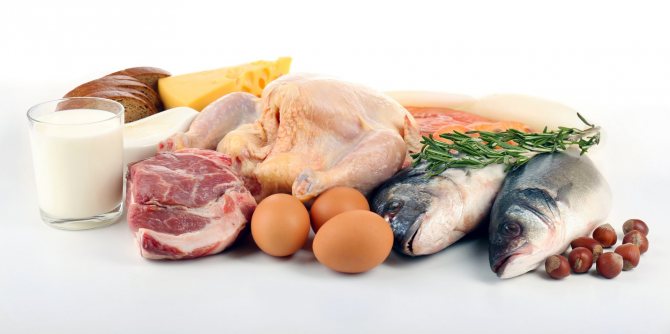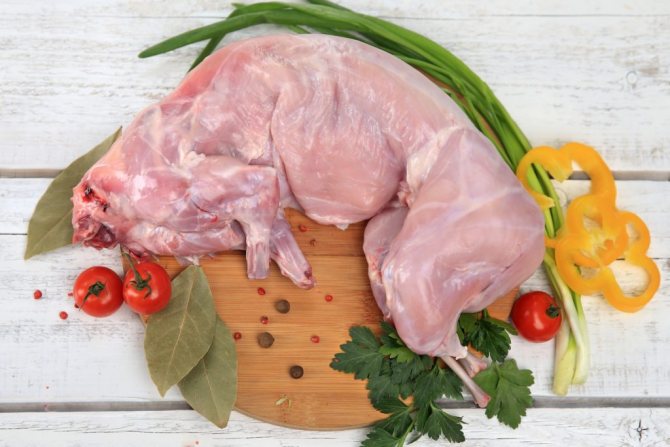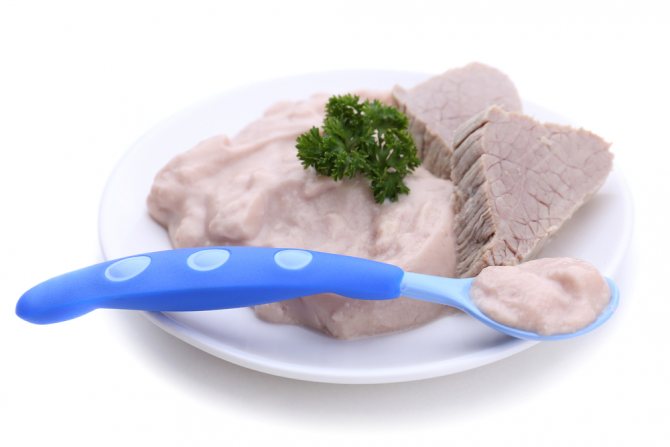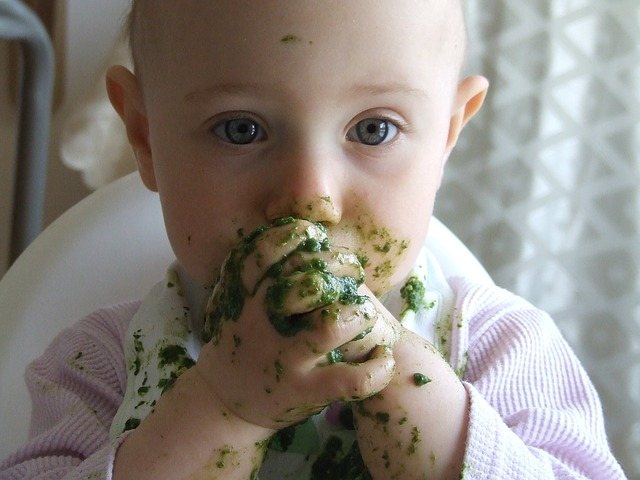Until six months, children eat only mother's milk or formula; until this age, they do not yet need other products. After 6 months, the baby needs much more nutrients than those found in breast milk or formula. From this age, the baby is gradually taught to eat cereals, vegetables, and fruits. When is the time to introduce your baby to meat? What meat do you give first? How to prepare baby meat puree? How much meat should a child under one year of age and older eat at one time?
The benefits of meat for children
Recently, the number of vegetarians has increased. These are people who, for personal reasons, do not eat meat products. If such a couple has a child, they most likely will not feed him meat either.
Disputes about the way children eat are heating up in earnest. Vegetarian parents passionately defend their positions, believing that animal protein can be replaced with plant protein. Doctors have a different point of view. In their opinion, meat is necessary for a child in any case, since meat protein cannot be replaced 100%, and, in addition to protein, it contains a special complex of vitamins and minerals.
Composition and nutritional value
To understand why meat is so important, you need to familiarize yourself with its composition:
- B vitamins. They are needed primarily to support the brain and nervous system.
- Zinc;
- Calcium;
- Phosphorus;
- Iron, and it is contained here in an easily digestible form, that is, it is perceived by the body better than from plant products;
- Valuable amino acids that are not produced by the human body;
- A balanced protein, necessary for human growth, strengthening the immune system, and for the proper development of the child’s hormonal system.

Animal Protein Sources
Note! Vegetarians believe that meat can be replaced in terms of benefits with plant foods. It is impossible to do this completely. It is quite possible to choose a complex of vitamins and minerals. Together with vegetarian protein, it will resemble meat in composition. At the same time, all useful elements will be absorbed worse by the body. This is not fatal for an adult, but dangerous for a child.
How to choose the right meat
First complementary foods while breastfeeding
Meat should be introduced into complementary foods correctly, following all recommendations. The baby’s gastrointestinal tract is not yet ready to immediately accept such heavy food in large quantities. Therefore, you need to introduce him to it gradually and correctly choose which meat product to give to the baby.
Types of meat
Meat complementary feeding can be started with the following types of meat:
- Beef. This is red meat, which contains a lot of iron.
- Veal. It is more tender than beef, which is why it is often introduced first into complementary foods for children. There are three types of veal: bacon, meat, fat. Babies are allowed to be given only the first two types.
- Rabbit meat. It has more protein than beef. It is also dietary meat, low-fat and easily digestible.
- Chicken and turkey. This meat is slightly fattier than rabbit (and chicken to a greater extent). At the same time, it contains the right unsaturated fatty acids, so it is also easily absorbed by the gastrointestinal tract.

Rabbit carcass
- Liver (beef, poultry, pork, veal) contains the maximum iron among all types of meat. It is very important to choose the right piece. It should be light, bright in color, smooth.
- A heart that also contains a lot of iron.
- Tongue (beef or pork) is a fairly light meat dish.
It is better not to give pork (except liver) to a child until he is one year old. This meat is fattier than all of the above. This means that this is heavy food for the baby.
On a note. It is better to wait up to a year to introduce pork into your diet.
Carcass parts
Kidneys, lungs, brains, udders - things that are not suitable for feeding a baby under one year old. Only the stomach of an adult, not a baby, can digest them. It is forbidden to give a small person aspic, especially one made with bone broth or pork legs. You need meat without fat, for example, pulp, tenderloin. It is better to choose those parts that move the least in a living animal - they are the most tender.
Which is better: ready-made or jarred?
When asked which is better, pediatricians advise choosing canned baby meat for the first complementary foods, explaining everything by its consistency. It closely resembles the consistency of puree and does not contain fibers, so it is easier to chew for even inexperienced babies. It is difficult to achieve such a mushy state at home.
In addition, it is produced strictly according to GOST standards and saves mom time. Despite the fact that the country exercises strict control over the quality of children's products, you should carefully read the ingredients before purchasing. It is important that there are only natural ingredients.
Canned meat is inferior only to domestic meat, when poultry or animals were raised independently and fed only with proven feed.
When is meat introduced into complementary foods?
Complementary feeding at 8 months while breastfeeding
According to WHO standards, a child can be given meat when:
- His complementary foods include at least vegetables, and even porridge;
- The baby is 7-8 months old.
Before the specified period, meat can be given to infants only if directly prescribed by a doctor. This is sometimes done in cases of anemia in children; sometimes a doctor’s recommendation prescribes starting meat complementary feeding at 5-6 months. There is no need to rush into introducing meat on your own.

Weaning puree
Artificially fed infants can begin their introduction to meat a little earlier, in consultation with their doctor. You can introduce meat into complementary foods for your child as soon as he becomes familiar with vegetables and cereals. Since IV infants often begin to be fed at 4 months (“natural babies” are closer to six months, according to WHO recommendations), they will become familiar with meat earlier.
Meat recipes for kids
When to introduce potatoes into complementary foods when breastfeeding a newborn
Most often, children are introduced to meat in a ground state. Meat puree for complementary feeding can be bought in the store; it is given out at the dairy kitchen. It's easier for parents - you don't have to prepare anything yourself. The composition of such a jar may leave much to be desired. For example, many baby food brands are guilty of adding starch to reduce the cost of production. That’s why some mothers prefer homemade complementary foods to store-bought ones.
Puree
It’s not difficult to prepare meat puree for your baby’s first feeding. Below are step-by-step instructions on how to make it. For it you will need:
- Just a piece of meat. For the first feeding, beef, veal, turkey or rabbit are best suited. Chicken and permissible offal are allowed only after them.

Meat puree
Cooking method:
- Skin, veins, cartilage, fat, and films are removed from the selected meat. The piece is washed under running water. It is cut into smaller pieces - about 10 cm long each. You need to start complementary feeding with one spoon, gradually increasing the portion to 70-80 grams. Therefore, there is no need to cook the whole piece at once, because meat puree for baby’s first complementary feeding is stored for no more than a day. One small piece is left, the rest are put into portion bags and frozen for next time.
- Beef, veal, turkey or rabbit need to be boiled. Moreover, be sure to change the water after the first boil - substances harmful to the child will be released into it. Next, turkey and veal should be cooked for an hour and a half, beef or rabbit - up to two. No salt, much less spices, should be added to the water.
- When the meat has been cooked for the required amount of time, it is taken out and cut into small pieces. Next, you need to grind them using a blender. To achieve a uniform consistency, you can add a couple of spoons of a mixture familiar to your baby or vegetable broth to the mixture (meat is prohibited).
You can add cold-pressed olive oil to the meat. The product will be digested better with it.
Souffle
Another form of children's meat dish is meat soufflé for children. This is a light, juicy and tender dish that can be given to infants after they have become familiar with purees and dairy products, that is, no earlier than 10 months. To make it a little more difficult, to avoid any problems, just follow the recipe description below.
To prepare a meat soufflé for a child of the first year of life, you need:
- Lean beef – 500 gr.;
- Three eggs;
- A glass of milk;
- Half a glass of cream;
- A little vegetable oil;
- Salt.

Meat soufflé
Prepare beef soufflé for a child like this:
- First, clean and wash the meat. There should be no films, veins, excess fat or bones left on it. Then the large piece is cut into smaller pieces.
- To make the soufflé very tender, the meat is steamed. A slow cooker or double boiler is suitable for these purposes. The beef is simmered there for about 40 minutes. When cooking in a double boiler, cover the container with foil so that the meat floats in its juices.
- When the beef is ready, place it in a blender. If this is not the case, a meat grinder will do. After grinding, you should get finely ground minced meat. Eggs, milk, cream and a small pinch of salt are added to it. Then the whole mixture is whipped again until smooth.
- After whipping, the future soufflé needs to be baked in the oven. The mold is greased with oil, and the whipped mixture is transferred there. All this is baked at 180 degrees for 40 minutes.
The finished soufflé should cool slightly, then transfer it to a common plate.
Soups with meat
So, we found out at how many months you can prepare meat products for your child. And when should soup with meat broth, vegetable soup with beef or rabbit meat, and everyone’s favorite borscht be introduced into a child’s diet?
Vegetable broths with meat
Soup with meat can be given to children from about the eighth month of life. Naturally, now we are not talking about a rich meat broth, but about a dish cooked with vegetables.
That is, you first need to cook the vegetable broth, and then add separately cooked pieces of meat to the almost finished soup.
As children approach one year of age, they are gradually acquiring teeth, which is why the finished soup can not be turned into puree, but simply kneaded thoroughly. At about 11 months, a little buckwheat, rice, millet or barley is added to the vegetable broth. Little gourmets will definitely like these soups.
Vegetable soups with meat broth
Meat broth should be prepared for a child over one year old (in some sources, from 1.5 years old). However, the soup should be cooked according to certain rules, slightly different from the adult version:
- the first broth needs to be drained, and the soup needs to be cooked in the second broth so as not to overload the child’s stomach;
- when the second water boils, the meat is cooked until almost fully cooked;
- then small slices of vegetables are added to the broth, and the soup is cooked until they are soft.
The finished soup with meat broth does not need to be over-salted; it will be enough to throw a tiny pinch of salt into the pan for taste.
If the baby does not like such a dish, you need to check that the vegetable component does not include too many aromatic components (onions or garlic) or foods that are unpleasant for the child (for example, cauliflower).
It is also worth making sure that the soup made from meat broth is of the correct consistency, otherwise it will simply be difficult for the baby to swallow it. If this doesn’t help, don’t give this dish to your baby for a couple of weeks or try a different vegetable combination.
Borsch
Often new parents are interested in how many months it is allowed to cook borscht for a child.
Opinions on this matter are quite controversial, but many pediatricians believe that a baby should be fed this soup after a year or even better after 18 months. Borscht is still quite a filling and heavy dish.
Almost every family has its own recipe for borscht, but one of the main components is beets. Therefore, before cooking real red borscht, you should introduce the baby to beets; if an allergy has not manifested itself, you can prepare the soup.
Borsch includes only familiar products:
- cabbage;
- carrot;
- potato pieces;
- meat (beef or veal);
- beet.
Borscht is cooked in both vegetable and meat broth. Just don’t use chicken broth as a base, as it is also highly allergenic. Also, you should not add a common component to borscht - vinegar or other acid.
Norms of complementary meat feeding by month
Giving your baby too much meat is dangerous. The gastrointestinal tract must get used to this kind of food. Therefore, the introduction of complementary foods requires adherence to the principles of timeliness and moderation.
What to combine with
Since meat is most often not the first product in a child’s diet, it can be combined with other ingredients, for example, vegetables or cereals. This combination is the best option for lunch.

Child having lunch
How often to give
Meat is a must in a child's diet. It is better if it is present in it every day, during lunch. If the child does not like meat, then it can be given once every two days.
Quantity
On average, the norm of meat for a child under one year is as follows:
- 7-8 months – gradual introduction up to a portion of 30-40 grams;
- 8-9 months – 50 grams portion;
- from 9 months and up to one year of age - a portion of up to 70-80 grams.
Important! There is no clear norm.
It all depends on the individual needs of the body. Some people need 700 grams per week. meat, for others 150-200 is enough. Both options are normal, provided that the child is healthy and ready to eat meat.
Table of introduction of various dishes according to the age of the child
Introducing a newborn to new foods should happen gradually. On the first day, the little one should be offered 1 teaspoon of the dish; if there are no negative consequences, then the next day the portion is increased to 2 spoons. In subsequent days, the daily increase becomes twice as large as the previous one, this continues until the volume required for a given age norm is reached.

The resulting table has all the information about the expected timing of the introduction of various dishes. Due to the individual characteristics of the baby’s body, the schedule may differ slightly in the timing and order of introduction of individual products. So for thin children, porridge is added at the beginning, and then vegetable purees, but for well-fed toddlers everything is exactly the opposite.
| The table shows in detail the correct timing and volume of products introduced. If an allergic reaction occurs to a number of components, they can be excluded for up to a year, after which you can again try to introduce the child to the dish. |
Possible problems when feeding meat
A child may react poorly to the introduction of meat into the diet. This happens more often if parents are in too much of a hurry. Symptoms that something has gone wrong:
- Bloating;
- Increased gas formation;
- Oily, pasty stools;
- Stomach ache;
- Allergy (most often to chicken).
If any of these signs appear, you should consult a doctor with your sick child.
Meat is important for the normal growth and development of the baby. It must be entered correctly. Then you will be able to get the maximum benefit from complementary foods and avoid unnecessary problems.











